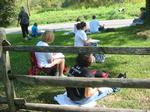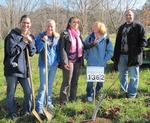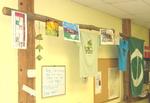Posted on Wednesday, January 5, 2011
The Westminster College Art and Nature course has a natural home away from the main campus of the college. That home is the Field Station. Here there are trees that grow as statues anchored to the earth by roots, flowers that bloom on cue from day length, wild places like muck in the wetland and intricate features seen only with the aid of microscopes.
George Bernard Shaw is credited with saying that "without art, the crudeness of reality would make the world unbearable." He is right! Nature involves some crudeness like dirt, streams that overflow their banks and crooked limbs that fall from trees. These crude and beautiful objects are worthy of the artist's sketchbook and field journal. Some of these crude objects are translated into paintings and collages by art students enrolled in Art 105 with Peggy Cox, professor of art. This has been going on for five years at the Field Station and gives our unique facility yet another reason to exist as an outdoor laboratory of Westminster College.
This fall, the students in Art and Nature made nearly a dozen ventures into the crude spaces that are here. They perched on folding chairs or squatted on the ground. Dirt stains were ignored. They also came inside the Nature Center to peer through microscopes where pine cones of different sorts were there to have them appreciate the timeline of three years between the release of microscopic pine pollen and the visible pine seeds. They planted seedling redbuds in our Microforest that cemented a connection with the earth. Their hands, from nearly all these activities, showed stains of watercolor, dirt or grass.
Artists' views of nature are often different from views scientists bring to a scene. Scientists are enamored of picky details of diversity and measurements of various sorts. They like numbers. Scientists see nature through eyes that are keen for details of "what" and "how." Artists see nature and tell us "why." Together they explain the world.
Inside the Nature Center of the Field Station is a crude branch from an American elm that is fastened by pegs between beams of a 19th-century "bank barn." This horizontal branch supports art work from many sources - drawings by local middle school children and banners or T-shirts that convey messages. One child's painting states in boldface, "ART IS SPLATTERED EVERYWHERE." That says it all!
Soon that branch will support works of art from Ms. Cox's fall semester class. Some of these just may be masterpieces!
Art, to be properly appreciated, must be periodically replenished and rotated in its setting to give the viewer new and fresh perspectives.That will happen as future middle school children and college art students display what they see as the "why" of nature. The world is "bearable" because science and art push us in the same direction that may sometimes appear to be opposite. Actually, they are in the same and complementary direction.
Clarence Harms, Director
Field Station
724-946-6001
harmsc@westminster.edu



